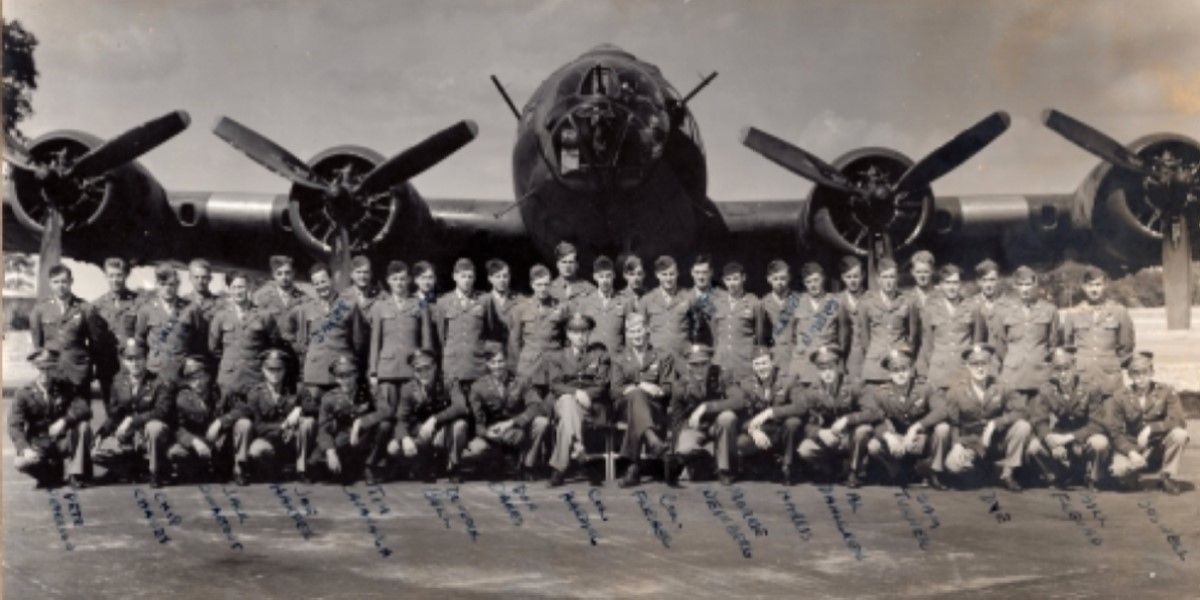The Big Picture
- Masters of the Air, the latest World War II miniseries from the creators of Band of Brothers and The Pacific, premieres on Apple TV+ on January 26, 2024.
- Based on the book Masters of the Air: America’s Bomber Boys Who Fought the Air War Against Nazi Germany, the series tells the true story of the 100th Bombardment Group of the American Eighth Air Force.
- The 100th Bombardment Group faced numerous challenges and losses during their missions, earning them the nickname “the Bloody Hundredth,” but their relentless efforts and sacrifices contributed to the Allied victory.
Masters of the Air, the long-gestating companion series to Band of Brothers and The Pacific, is set to premiere on Apple TV+ on January 26, 2024. Executive producers Steven Spielberg, Tom Hanks, and Gary Goetzman, who were behind the first two World War II-based miniseries, have returned for the third series, virtually guaranteeing the latest will live up to the lofty standards set by its predecessors. Masters of the Air is based on Donald L. Miller‘s novel Masters of the Air: America’s Bomber Boys Who Fought the Air War Against Nazi Germany, the true story of the 100th Bombardment Group of the American Eighth Air Force. And what a story it is.
How the ‘Masters of the Air’ Got Their Start
The 100th Bombardment Group, the heroes behind Masters of the Air, started life on paper at Orlando Army Base in Florida on June 1, 1942. By special order, 230 enlisted men and 24 officers were transferred to the 100th on October 27, 1942, stationed in Boise, Idaho, but the unit wasn’t officially activated until November 14, 1942, with Col. Darr Alkire as their first Commanding Officer. In all, there were 37 crews, with 10 men each. Their first practice mission on April 20, flying from Kearney, Nebraska to Hamilton Field, California, did not go well, leading to Alkire being relieved of his command in favor of Col. Howard Turner on April 26. Twenty days of advanced training were put in by the group before they were ready to progress, and on May 25, 1943, 35 crews in total flew to England, and on June 8 they were stationed at Station 139 in Thorpe Abbotts, England where they would remain until the end of the war.
Their first combat mission saw the 100th attack submarine yards at Bremen, Germany on June 25, 1943. Three planes and 30 men were lost over Bremen in the attack, the first of many losses, which would earn the group its notorious nickname: the Bloody Hundredth. It came by the name honestly, as there are multiple instances where the 100th would lose between 12 and 13 aircraft on a single mission. Following that first mission, Col. Neil B. “Chick” Harding (played by James Murray in the series) would take over as command, a post he would hold until March 1944. The 100th concentrated its attacks on German airfields, submarine facilities and aircraft industries over the next six months. During that time, the 100th flew one of its most successful missions in the air above Regensburg on August 17, 1943. Although nine crews were lost on the raid, the attack on the German aircraft factory severely impacted production, with the factory estimated to account for 25 to 30 percent of all Germany’s single engines. The group would receive its first Distinguished Unit Citation for its part in the operation.
The ‘Masters of the Air’ Go From “Black Week” to “The Big Week”
The 100th Bombardment Group had more than its share of dark days in World War II, but none were as bad as October 8-14, 1943, unceremoniously dubbed “Black Week.” As told in the previously cited Royal Air Force Mildenhall website, Bremen was the target on October 8, and after the mission seven B-17s were MIA, six were heavily damaged, and one had to be salvaged, leaving the 100th only 17 aircraft for the next day’s target, Marienburg, Germany. No planes or crew members were lost that day, but the attack on Münster on the 10th was a very different story. The 100th sent 18 B-17s and another two from the 390th that day. Seven were forced to abort over the North Sea, leaving only 13 to complete the mission. In an interview with Aerotech News, WWII veteran Master Sgt. Dewey Christopher recalls what happened next. “Our group took off for Münster, (Germany) and only one airplane came back — we lost the rest of them,” he said. “Rosie Rosenthal (played by Nate Mann in the series) was flying ‘Royal Flush’ — the one aircraft that made it back to Thorpe Abbotts.”
Heading into 1944, the 100th began targeting marshaling yards and missile sites in addition to airfields and industries, and in March 1944, they joined the Allied initiative known as “The Big Week,” a concentrated attack on German aircraft factories. Their actions there earned the group their second Distinguished Unit Citation, while attacks on heavily defended German installations and missions to drop supplies to French forces would earn them the French Croix de Guerre with Palm. On June 6, 1944 — D-Day — the 100th bombed bridges and gun emplacements in order to support the famed Allied invasion. The 100th would continue their efforts throughout the war, flying its last combat mission on April 20, 1945. During that operation to Berlin, the 100th went out on a high with no losses recorded.
In all, the statistics are a stunning picture of what the 100th Bomb Group accomplished, and the tremendous losses to do so. As found on the official website of the 100th Bomb Group Foundation, previously cited, between their first mission on June 25, 1943, and their final mission, the 100th recorded 306 missions in total. During those missions, the 100th was credited with 8,630 sorties (a sortie is when an aircraft on a combat mission is subject to enemy attack while performing the mission), a total bomb tonnage of 19,257, and 435 tons of food on humanitarian missions. The gunners of the 100th claimed 261 enemy aircraft shot down (including a ME-262 German jet fighter, among the first gunners to do so), 1,010 probably destroyed, and 139 possibly destroyed. In all, the 100th losses included 184 missing air crew reports, 229 planes either lost or salvaged, 757 men KIA/MIA, and another 923 taken as prisoners of war. Theirs is a story worthy to be told, and at long last, Masters of the Air will bring that story to a whole new generation, becoming another vivid reminder, among many, that the rights and freedoms we hold today, the same rights and freedoms we often take for granted, came at a great cost
Denial of responsibility! TechCodex is an automatic aggregator of the all world’s media. In each content, the hyperlink to the primary source is specified. All trademarks belong to their rightful owners, and all materials to their authors. For any complaint, please reach us at – [email protected]. We will take necessary action within 24 hours.
Khushi Patel is a science fiction author who lives in Austin, Texas. She has published three novels, and her work has been praised for its originality and imagination. Khushi is a graduate of Rice University, and she has worked as a software engineer. She is a member of the Science Fiction Writers of America, and her books have been nominated for several awards.



